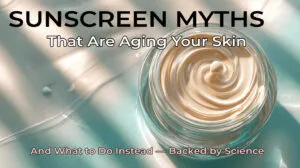Your skin’s story begins in your gut.
The secret to youthful, radiant skin isn’t found in a jar — it’s living inside you.
Scientists refer to it as the skin-gut connection, a communication system that links digestive health to skin appearance and the rate of aging. A balanced gut microbiome creates a state of reduced inflammation while enhancing nutrient absorption and maintaining a strong collagen structure. The absence of gut health balance leads to skin problems, including dullness, dryness, and early signs of aging lines.
This guide explains how gut health influences visible aging through microbiome science and provides methods to achieve a radiant, glowing skin — from the inside out.
How the Gut Talks to Your Skin
Your gut and skin maintain an ongoing dialogue through the skin-gut connection, which operates as a two-way communication system. Your gut microbiome uses biochemical signals through the immune, endocrine, and nervous systems to control inflammation, hydration, and collagen production.
When your gut microbiome operates at equilibrium, your skin maintains a state of calmness and resilience because beneficial microbes produce short-chain fatty acids, antioxidants, and neurotransmitters. The immune system becomes stronger while oxidative stress decreases, and the lipid barrier functions to retain moisture.
The gut’s equilibrium state determines the nature of its communication with the skin. The skin becomes more susceptible to dryness, irritation, and premature wrinkles when inflammatory signals increase, while antioxidants decrease, and the skin barrier becomes weaker.
Your microbiome operates as a behind-the-scenes system for your skin, producing positive results when it functions properly but creating adverse effects when it is not in harmony.
Dysbiosis and Premature Aging
When your gut falls out of balance, your skin often sends the first signal.
Dysbiosis occurs because harmful bacteria outcompete beneficial bacteria. The disrupted skin-gut connection leads to higher levels of IL-6, TNF-α, and NF-κB, which promote aging from within.
The body displays external signs of internal stress through several changes that occur with time.
- Loss of ability to maintain elasticity and firmness.
- An uneven texture, while becoming dull and dry.
- Increased dryness and sensitivity
- More frequent breakouts, accompanied by increased redness.
Scientists identify this process as inflammaging because it causes skin damage through continuous, low-level inflammation that occurs in the absence of any disease. The breakdown of your gut barrier allows toxins and bacteria to enter your bloodstream, which triggers immune responses that damage collagen and exceed your skin’s repair capabilities.
The good news? Your microbiome is remarkably resilient. Proper nutrition and practicing daily routines that help restore balance to your microbiome — and your skin will often be the first to reflect that recovery..
Probiotics, Prebiotics, and Postbiotics: Nourishing the Skin-Gut Connection
Your gut functions as the central control system for health, so probiotics, prebiotics, and postbiotics operate as its supporting team to maintain microbiome equilibrium and skin health. The three components work independently to defend your skin-gut connection while combating signs of aging that appear on your skin.
Probiotics — The Restorers
The beneficial live bacteria in probiotics help restore microbial equilibrium when your body experiences stress or when you consume unhealthy food or take antibiotics. Specific bacterial strains help decrease inflammation while soothing skin sensitivity and enhancing moisture levels in the skin.
The most effective probiotic strains for skin health include Lactobacillus rhamnosus GG, Bifidobacterium longum, and Lactobacillus plantarum.
Prebiotics — The Nourishers
Plant fibers and polyphenols serve as food sources for beneficial bacteria, which enable them to grow and maintain a robust gut barrier.
The prebiotic compounds inulin and resistant starch from oats, green bananas, cooled potatoes, berries, cocoa, and green tea serve as food sources.
Postbiotics — The Protectors
The fermentation products of beneficial bacteria, known as butyrate, function to decrease inflammation while they enhance gut-skin cell communication.
These three microbial partners unite to defend your skin barrier while protecting collagen and enhancing your natural skin glow through internal health support.
Diet and Lifestyle for a Balanced Skin-Gut Connection
Your body sends signals to your microbiome through every mouthful you eat and your skin receives these messages. The same dietary choices which support gut health protection also create barriers against skin inflammation and early aging and skin dullness.
Feed Your Microbiome Daily
- High-fiber foods: vegetables, legumes, whole grains
- Fermented foods: yogurt, kefir, kimchi, sauerkraut, miso
- Healthy fats: omega-3s from salmon, flaxseed, walnuts
- Polyphenols: berries, green tea, cocoa, olive oil
Hydrate, Rest, and Rebalance
- Drink plenty of water and mineral-rich fluids
- Sleep 7–9 hours for nightly gut and skin repair
- Manage stress to prevent cortisol-induced microbiome disruption
Avoid What Ages You Faster
The consumption of refined sugars, seed oils, and ultra-processed foods leads to inflammation and glycation, which cause collagen stiffness and deterioration of skin tone.
The Future of Microbiome-Based Skincare
The beauty industry now focuses on discovering hidden beauty elements that exist beneath the skin’s surface. Scientists are now investigating the impact of gut microbiome health on skin aging, given the connection between the skin and gut.
Topical Probiotics and Synbiotics
Skincare products now incorporate beneficial bacteria and prebiotics to create a more substantial skin barrier while minimizing skin irritation.
Personalized Microbiome Testing
Modern wellness laboratories now perform microbial profile assessments to create personalized dietary plans and skincare recommendations tailored to each individual.
The Longevity Connection
The microbiome maintains longevity by decreasing inflammation, enhancing mitochondrial function, and supporting proper immune system function, which leads to healthy aging skin.
The Skin-Gut Axis: Quick Science Summary
The skin-gut connection demonstrates that inner balance creates outer beauty. A balanced microbiome reduces inflammation and oxidative stress, which enables your skin to flourish.
| Mechanism | Effect on Skin | Supporting Nutrients |
|---|---|---|
| ↓ Inflammation | Calmer, even tone | Omega-3s, Curcumin |
| ↓ Oxidative Stress | Fewer fine lines | Polyphenols, Green Tea |
| ↑ Barrier Function | Hydrated, less redness | Collagen Peptides, Zinc |
| ↑ Collagen Synthesis | Firmer texture | Vitamin C, Glycine |
| ↑ Microbial Diversity | Clearer complexion | Prebiotic Fiber, Fermented Foods |
Takeaway: Heal the Inside, Reflect It on the Outside
The skin-gut connection reveals a powerful truth — lasting beauty begins within.
Your microbiome health determines the level of inflammation in your body, which protects collagen and leads to a healthy skin appearance. Your skin can achieve natural vitality through gut balance maintenance, which can be achieved by eating a balanced diet, getting sufficient rest, and practicing mindful living.
Healthy gut, radiant skin. That’s the power of the skin-gut connection.
Related Longevity Decoder Guides
Pterostilbene Anti-Aging Cream — Cellular Repair for the Skin Barrier
Retinol for Beginners — How to Start Without Irritation
Science-Backed Skincare Ingredients That Actually Work
Further Research
Bowe, W. P., & Logan, A. C. (2011). Acne vulgaris, probiotics and the gut–brain–skin axis – back to the future? Gut Pathogens, 3(1), 1. https://doi.org/10.1186/1757-4749-3-1
Clark, A. K., & Mach, N. (2016). Exercise-induced stress behavior, gut–microbiota–brain axis and diet: A systematic review for athletes. Journal of the International Society of Sports Nutrition, 13, 43. https://doi.org/10.1186/s12970-016-0155-6
De Pessemier, B., Grine, L., Debaere, M., Maes, A., Paetzold, B., & Callewaert, C. (2021). Gut–skin axis: Current knowledge of the interrelationship between microbial dysbiosis and skin conditions. Microorganisms, 9(2), 353. https://doi.org/10.3390/microorganisms9020353
Knights, D., et al. (2021). The human microbiome and immune system: Insights into inflammatory and autoimmune diseases. Annual Review of Immunology, 39, 147–170. https://doi.org/10.1146/annurev-immunol-102919-023636
O’Neill, C. A., Monteleone, G., McLaughlin, J. T., & Paus, R. (2016). The gut–skin axis in health and disease: A paradigm with therapeutic implications. BioEssays, 38(11), 1167–1176. https://doi.org/10.1002/bies.201600008
Roubalová, R., et al. (2020). Gut microbiota and skin aging: Impact of probiotics and prebiotics. Nutrients, 12(5), 1470. https://doi.org/10.3390/nu12051470
Yoon, H. S., et al. (2015). Effect of Lactobacillus rhamnosus GG on atopic dermatitis in adults. Clinical Nutrition, 34(1), 108–113. https://doi.org/10.1016/j.clnu.2014.02.002





